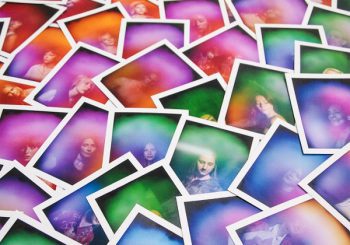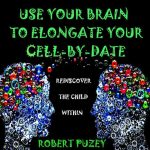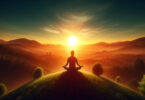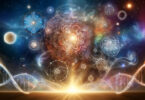 By Robert Puzey
By Robert Puzey
Guest Writer for Wake Up World
‘To see one’s true colours’:
There is an abundance of old English sayings that refer to colour. A ‘green eyed monster’ represents jealously. A ‘yellow belly,’ figuratively speaking, is a coward, with a yellow streak down his back. To have the ‘blues’ signifies being down in the dumps, so on and so on. ‘To see one’s true colours’ has a hidden meaning programmed and stored in our ancient memory banks. Our mundane usage of this old saying only comes into effect when someone lets us down, or we see a side to a person we dislike and haven’t encountered before. But we are capable of seeing a person’s true colours before we are hurt or deceived.
The Aura
Around each one of us is a magnetic field of static energy made up of atoms and molecules – the aura. These particles of electricity are invisible to the naked eye (or should I say untrained eye), but these highly charged minute heat receptors display our feelings and emotions externally, by way of ever-changing colours that vibrate about us. Some of these colours, due to physical change, can be viewed by the naked eye. For instance, when we are frightened or something stirs our emotions we produce goosebumps, sweat, and tremble, all of which is a remnant of our ‘fight or flight’ instinct. So our aura is an extension of inner forces and outward physical reactions.
Gifted healers are known to observe dark patches in our energy field that can represent illness, past ailments, and grief. This explains how a healer’s hands can go straight to the spot where a patient feels the pain. The dark patches in the astral body correlate to dark areas in the physical body. By this code healers can not only define disease, but also talents, traits, and spiritual development. Shades of blue are said to be healing qualities, colours you would expect to see in a healer’s energy. White in the aura is seen as the sign of a highly evolved being.
Ancient man
Millions of years ago ancient man had to rely on natural instincts. Every day, for a meal, he had to fish in lakes and rivers, run through misty forests hunting dangerous animals, and fighting off rival hunters. These cave dwellers were equipped with very basic tools, e.g., a club, spear, or a bow and arrow. It was a case of ‘survival of the fittest’. Unfortunately homo sapient has lost much of his natural instincts down to modern day technology. Today’s Man is predisposed to watching TV, working on computers, and rather than travel by foot travel by car, train, boat, or air. In today’s world we throw something into the microwave, nuke it for five minutes, and sit and eat, with our mind taken with texting or watching TV. With so much effort and danger put into catching a deer or rabbit, ancient man wholly appreciate his food. Gone are the days when we ate plants and vegetables, picked berries or collected honey, felt the strength and aura of the forests, followed the cyclic orders of the moon and stars, and lived with the elements and other creatures as nature intended us to do. In fact, we have lost so much of our natural instincts, if we were left in the wilds today, I fear we wouldn’t survive the night.
Among the multitude of powers that have diminished for Man over time is the ability to see the aura. Just as a canine smells fear we could see it! Colours would help us to define friend or foe. The shame of it all is that we have probably only lost these blessed powers in the last few hundred years, thanks to technology.
Nowadays, these old sayings, ‘To see one’s true colours,’ ‘to have eyes in the back of your head’, etc., are taken lightly and viewed as old wives’ tales, but at the best of times, how these old saying can ring true. In the dense forest in the black of night I am sure we almost had eyes in the back of our head, in terms of seeing in the pitch darkness, sensing sounds and smells, almost giving us a parietal eye. And I am sure we had a highly sensitive eye for spotting the colour surrounding a fellow hunter or a red-toothed beast. However, all is not lost. We can, if we wish, redevelop some of our ancient instinctive prowess.
Try this exercise:
If you walk into a room at a party, and sense a bad atmosphere, discover where the negative vibes originate. Relax your eyes on the individual, whilst breathing deeply; do not think of the person as Sally or Fred, but rather as trillions of atoms and molecules. Keep looking, with relaxed eyes, and in time the said person’s aura will reveal itself to you.
Try this exercise:
Children’s postures are uninhibited, like their minds, leaving their energy channels wide open. Study the young, as they are easy pickings when it comes to aura hunting. Finally, remember that everything has an aura. Inanimate objects are blocks of atoms. The universe is in itself, but energy. Practise auric sighting, feeling and sensing energy with children to redevelop your ancient super-sensory perceptions.
Interpreting Aura Colours
There is no standard interpretation of aura colours; the important thing is to get to understand what these colours mean to you personally. Here are some suggestions to consider, one set based on our everyday colour associations, or an alternative set based on the colours of the 7 chakras:
Everyday Colours
1) To see RED: probably refers to the longstanding association of the colour red with passion and anger.
2) To feel BLUE: be sad or feel depressed.
3) You are YELLOW when you are too scared to do something. To have no courage.
4) GREEN with envy: full of desires for someone’s possessions; extremely covetous.
5) In the PINK: meaning in good health
6) Shrinking VIOLET: someone who is very shy and not assertive?
7) If someone is WHITER than WHITE, their actions are always completely honest and moral.
Breakdown of the 7 Unique Chakra colours
Root chakra: colour Red, Location: base of your spine near your tailbone.
Sacral chakra: colour Orange
Solar plexus chakra: colour Yellow
Heart chakra: colour Green
Throat chakra: colour Blue
Third-eye chakra: colour Indigo/Purple
Crown chakra: colour Purple/Violet
About the author:
 Robert Puzey is an award winning songwriter (Ivor Novello awards in the category of ‘Songwriter of the Year’ and ‘Most Performed song of the Year’ (‘I’m in the Mood for Dancing’) 1980.
Robert Puzey is an award winning songwriter (Ivor Novello awards in the category of ‘Songwriter of the Year’ and ‘Most Performed song of the Year’ (‘I’m in the Mood for Dancing’) 1980.
Robert nursed his late wife, Kath, though her five-year battle against bowel cancer, during which time Robert extensively studied hatha yoga (he is a qualified hatha yoga instructor) and began to experiment with novel brain exercises in the field of ‘mind over matter’ / ‘spirit over worldliness’, achieving some quite revolutionary and fascinating results from his work.
 Bringing us up to date, Robert has formulated a complete programme – ‘Use Your Brain to Elongate Your Cell-by-Date’ – of rejuvenating exercises with easy to use instructions. Robert lives in north London and writes self-help material.
Bringing us up to date, Robert has formulated a complete programme – ‘Use Your Brain to Elongate Your Cell-by-Date’ – of rejuvenating exercises with easy to use instructions. Robert lives in north London and writes self-help material.
Facebook: https://www.facebook.com/rjpuz
‘Use Your Brain to Elongate Your Cell-by Date’ is available on Amazon here.

If you've found value in our articles, we invite you to support the release of our brand-new book, "Gratitude Practices for Kids: A Practical Guide for Adults to Instill a Spirit of Appreciation and Positivity in the Next Generation."
"Gratitude Practices for Kids" brings together over 25 innovative and accessible practices designed to enhance gratitude in everyday life. This comprehensive guide is backed by 17 scientific studies, ensuring each concept is grounded in research, underscoring our commitment to nurturing growth, emotional intelligence, and positive interactions between adults and children.
We encourage you to opt for the paperback version to celebrate this new release. Dive into its fresh pages away from digital distractions, allowing you to immerse yourself in the transformative practices it offers.
Over recent years, Wake Up World has faced significant online censorship, which has impacted our financial ability to operate. Moving into book publishing represents a strategic step to secure the ongoing funds needed to continue our mission. By purchasing Gratitude for Kids, you help us keep our content free and accessible to everyone, avoiding needing a paywall. With over 8,500 articles published in the last 13 years, we remain dedicated to keeping our valuable content open to all.







